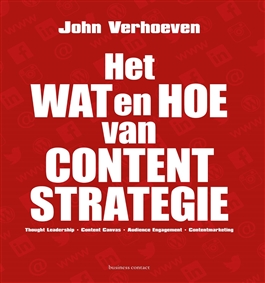Best of the Books I read #1: “Wat en Hoe van Contentstrategie” by John Verhoeven
To be clear: this is not a traditional book review. My goal is to take the highlights of the (marketing) books I read, their most valuable lessons, and share them together with my thoughts.
Now, for the highlight. I like how Verhoeven doesn’t just go straight to tips & tricks and ways of crafting content, but rather gives you paradigms on how to think about content. He distinguishes 3 perspectives or approaches, that can live side by side and each has its own use in the overall content offering.
Perspective 1: your solution
This is often a first knee-jerk reaction: let’s tell people about our product and how great it is. It can also be a logical starting point for your must-have content. When done right, ‘solution’ content is especially valuable in your hub and hygiene content, with tutorials, FAQ’s, helping consumers make the right choices, troubleshooting, and general company and product transparency. Making the solution perspective your main approach can work for some companies that have particularly interesting stories of innovation or craftsmanship, like Tesla, GE, or even wineries and craft beers. The trick here is to resist the urge to only talk about yourself: Your aim should be to show how and why your solution to a problem is different from your competitor's.
The problem lies in the credibility: you’re the judge of your own work, the jury of your own award show. The workaround here is asking for trustworthy, external sources and resisting the urge to polish the less shiny results of their findings. When you hire a journalist to write a background story about you, it’s understandable you want to have a right to edit it — after all, you’re paying! But realize that a bit of criticism adds heaps of credibility, and a total lack of anything questioned leaves you with little more than long-form advertising copy written by a non-advertising copywriter.
Overall, this approach can lead to nice brand stories, and some conversion, but can be perceived as a little distant and emotionally detached. You’re only interested in yourself, making your audience feel like just that: an audience.
Perspective 2: the issue
What issues keep your audiences up at night? What are the issues surrounding your product or your sector? Do you have a clear and educated view on this? Can you offer a valid and valuable perspective? Here you can show you know what’s going on, and claim thought leadership. Tapping into the dynamics of society is also a great way to get free publicity and show some personality and confidence by taking a stance. Not everyone will agree with you, but I think brands may need some opponents to gain advocates.
A problem with raising issues without providing clear solutions is the danger of sounding opportunistic or self serving. You may imply to have the answers to all problems after all. One way to mitigate this risk is by teaming up with respectable, trustworthy partners like NGOs, or branche organizations. For example, Pure Leaf tea teaming up with the Rainforest Alliance, or Adidas with Parley for the Oceans.
This approach can build a lot of brand love. It’s best to stay close to your own company purpose and issues that aren’t at odds with your own interests. A financial institution like Delta Lloyd teaching struggling people to keep track of their finances is credible. So is an internet provider talking about cybersecurity or cyberbullying. BP talking about saving the polar caps? Not so much. BP talking about workplace safety, geological changes or breakthrough technologies in plastics? A lot more credible.
Perspective 3: The need
Which fundamental need is satisfied by your service or product? To which core value do you appeal? This approach is about claiming insight into major human themes like safety, connection, recognition, convenience, doing good. Showing you truly understand people and what drives or affects them is a great way to earn some brand love. After all, feeling seen, understood and appreciated is the best way to create a connection.
The hard part of this approach is preventing a discrepancy between lofty words and the practice of everyday business. Especially in heavily price competitive markets like FMCG it’s not an easy approach, but it is possible. Think of Amstel beer providing sports teams with a platform to connect and organize all of ftheir team affairs — they aren’t so much claiming sports as they are facilitating connection and togetherness. Or Nike’s return to its driving idea that “if you have a body, you’re an athlete”, which isn’t so much about becoming the best athlete out there, but rather an empowering way of seeing and appreciating your body with a sense of ownership and agency. Dove’s campaign aimed at building women’s self-esteem and recognition of innate value and strength is a schoolbook example.
Of course, marketers love working from a need — it’s where the true heart of marketing lies. By expanding the area of your direct service or product to the general need and voicing well-thought-out opinions about it, you get to have a chance to market leadership, if not in numbers, then at least in thought or visibility.
So, how does that help me?
These three perspectives are complementary and you can connect them to your content mix of hygiene, hub, hero. You should try to incorporate all three of them as they all have their own uses and shortcomings. Depending on the skills and stories present in your company, your target audiences, and the issues in the industry you’re in, you can see what balance fits you best.
If you’re struggling to find a larger issue or need to claim around your company, service or product, don’t get discouraged too easily: you may find that the larger area around your product or service can cut through to people’s basic needs. Say, if you manufacture matches, you can speak about safety, or about the science of fire. You can talk about child safety, or survival in the wilderness. About preservation of the woods the matches come from or play with the nostalgia brought about by the smell and act of lighting a match. You can talk about family or moments of togetherness.
What I appreciate most about this approach of using the different perspectives, is that it gives you permission — if you still needed it — to speak beyond your direct product, USP or marketing messaging. It emphasizes how companies and organizations don’t operate in a vacuum and are allowed to have an opinion — it’s even appreciated. As long as you choose the area where you want to stake your claim in line with your company’s mission or purpose. I think that in general brands are too cautious to be perceived political, or to take a stance. If you see brands as people with their own personalities, it’s easier to see how that works. We appreciate those with clear opinions and points of view even when we don’t agree, and may even distrust the quiet ones. Show us your true colors!
The rest of the book:
Positive: “Wat en Hoe van Contentstrategie” gives you 7 practical steps to set up a solid content strategy and clear tools to execute it. It moves far beyond simple tips & tricks.
Negative: Throughout there is an undercurrent of disdain for sales conversion and the chapter on metrics is little more than a brush-off, giving it a bit of an old school vibe.
About Best of the books I read
In this series, I take highlights of books, the most valuable insights, and share them together with my thoughts. The books will mainly be about marketing, creative strategy, and brand identity. Some will be books that are available in English, some only in Dutch — but my writing is in English. Imagine that, you may learn something across language barriers!

